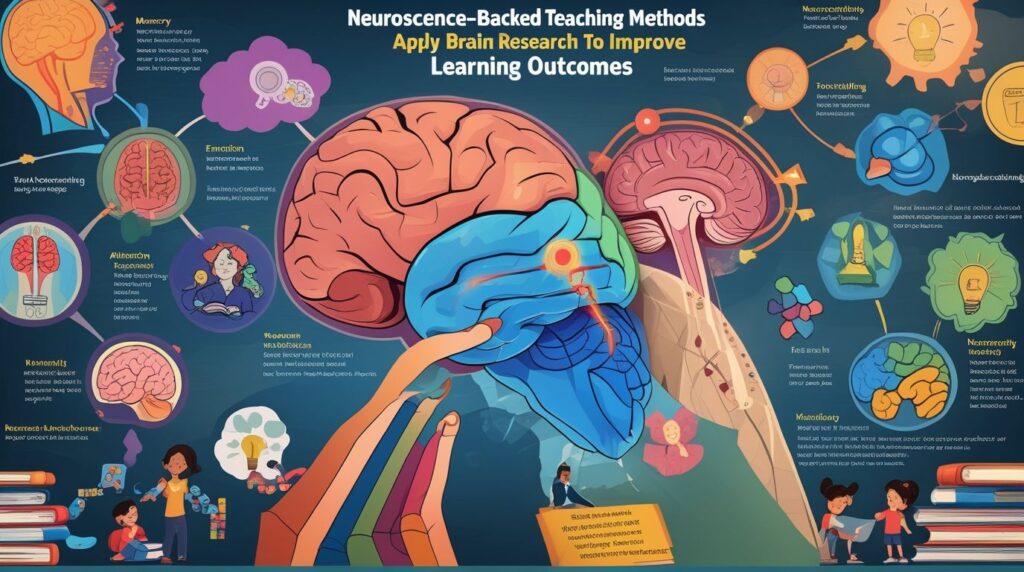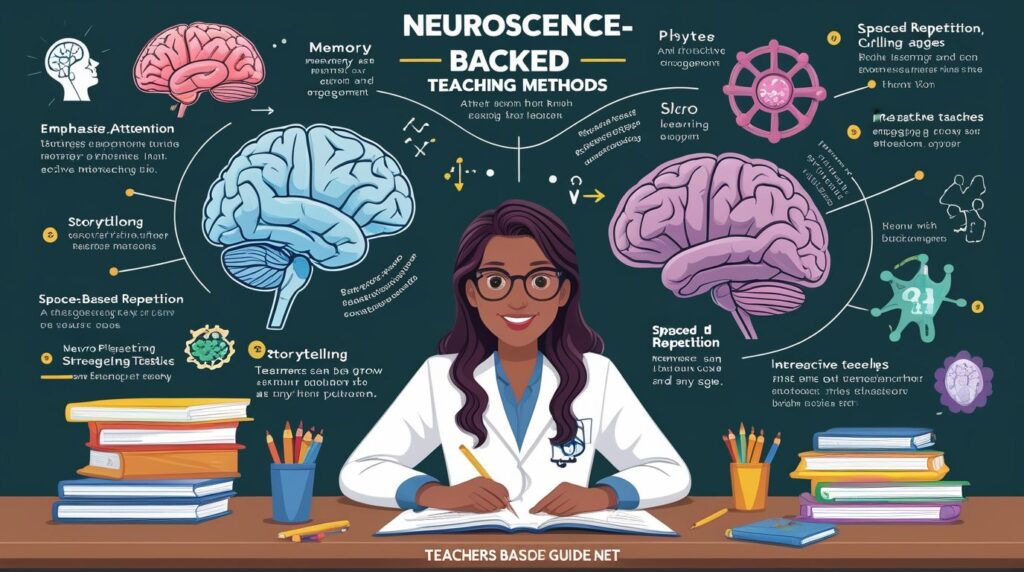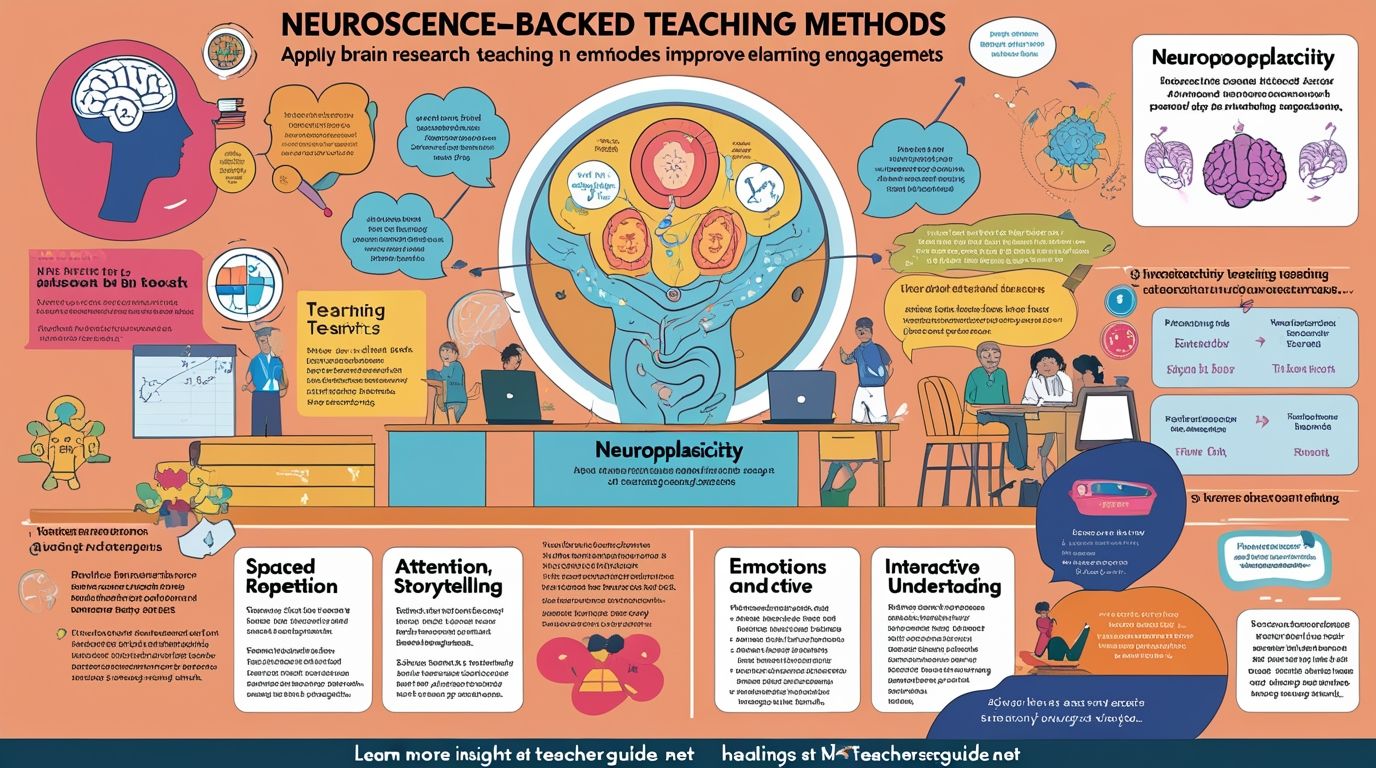Introduction to Neuroscience in Education
Neuroscience-Backed Teaching Methods, In recent years, neuroscience-backed teaching methods have gained significant attention in education. Neuroscience explores how the brain learns, remembers, and processes information. Applying these insights in classrooms helps teachers design effective strategies. For example, brain research shows how attention, memory, and emotions impact learning outcomes. As a result, educators can use evidence-based approaches rather than relying solely on traditional methods. Moreover, neuroscience explains why active learning and repetition strengthen understanding. It also highlights how stress or lack of motivation can block learning. Therefore, neuroscience provides a scientific foundation for teaching practices. Teachers who apply brain-based strategies enhance student engagement and performance. Additionally, these methods help cater to different learning needs. As education evolves, neuroscience is becoming an essential tool for effective instruction. Thus, neuroscience-backed teaching methods are shaping modern classrooms. Learn more about effective teaching at teachersguide.net.
Role of Memory in Learning
Memory plays a central role in neuroscience-backed teaching methods. Neuroscience research shows that repetition and retrieval strengthen long-term memory. Teachers can use strategies like spaced repetition to help students retain information. For instance, revisiting a concept after intervals makes learning more durable. Additionally, linking new information with prior knowledge supports deeper understanding. Visual aids, storytelling, and analogies also improve memory recall. Moreover, active learning—where students explain ideas in their own words—strengthens memory pathways. Teachers should avoid cramming methods, as the brain struggles with overload. Instead, structured revision enhances retention. Furthermore, emotional connections boost memory since the brain prioritizes meaningful experiences. This explains why students remember stories better than plain facts. Teachers who design lessons with memory in mind increase long-term success. Therefore, neuroscience emphasizes that memory-focused strategies are vital for effective learning. Schools must apply these principles to maximize learning outcomes.
Importance of Attention in Learning
Attention is another vital element in neuroscience-backed teaching methods. Neuroscience shows that the brain can only focus on limited information at once. Therefore, teachers must create engaging lessons that capture attention. Strategies such as short activities, interactive discussions, and visual stimuli help maintain focus. Moreover, frequent breaks improve concentration by reducing cognitive fatigue. Teachers should also minimize distractions in the classroom to enhance attention span. Additionally, connecting lessons to students’ real-life experiences increases interest. When learners see relevance, they are more likely to stay focused. Furthermore, curiosity-driven activities trigger the brain’s reward system, keeping students engaged. Teachers can also vary their teaching techniques to maintain novelty and interest. Since multitasking reduces effectiveness, focusing on one task at a time is crucial. Hence, managing attention effectively ensures better learning outcomes. Neuroscience-backed strategies thus highlight the importance of attention in classroom learning.

Role of Emotions in Learning
According to neuroscience, emotions strongly influence learning. Neuroscience-backed teaching methods emphasize the connection between feelings and brain function. Positive emotions release neurotransmitters like dopamine, which improve memory and motivation. Teachers can foster such emotions by creating supportive classroom environments. Celebrating achievements, encouraging collaboration, and reducing fear of failure are helpful strategies. On the other hand, negative emotions like stress or anxiety block cognitive functions. Neuroscience shows that a stressed brain struggles with memory and problem-solving. Therefore, teachers must ensure students feel safe and valued. Activities that promote empathy and teamwork also enhance emotional well-being. Moreover, storytelling and real-world examples trigger emotional responses, making learning memorable. By recognizing emotional factors, educators can design lessons that connect with students personally. Thus, emotions play a vital role in shaping how well learners absorb knowledge. Hence, classrooms must integrate emotional well-being with academic learning.
Active Learning and Brain Engagement
Neuroscience-backed teaching methods highlight the importance of active learning. The brain learns better when students participate actively rather than passively. For example, group discussions, problem-solving tasks, and hands-on experiments engage multiple brain areas. Neuroscience explains that active participation strengthens neural connections. Additionally, when learners teach concepts to peers, they deepen their own understanding. Movement-based learning activities also improve brain function by increasing blood flow. Moreover, questioning techniques stimulate critical thinking and problem-solving skills. Teachers can use project-based learning to encourage creativity and collaboration. Such activities not only boost memory but also enhance motivation. Furthermore, active learning increases attention span compared to passive listening. Students also develop confidence when they contribute actively. Thus, classrooms that prioritize active engagement foster better outcomes. Therefore, neuroscience strongly supports interactive and participatory teaching practices. Schools must integrate these approaches for effective and brain-friendly education. More insights are available at teachersguide.net.
Role of Sleep and Rest in Learning
Sleep and rest are often overlooked but essential in neuroscience-backed teaching methods. Neuroscience research proves that sleep consolidates memory and supports problem-solving. During rest, the brain processes and stores information from the day. Therefore, students who get enough sleep perform better academically. Teachers should encourage healthy sleep habits and avoid excessive homework that disrupts rest. Short breaks during lessons also refresh attention and memory. Additionally, power naps can improve alertness and recall in older students. Neuroscience shows that lack of sleep reduces focus, creativity, and decision-making. Hence, classrooms must recognize the importance of balancing study with rest. Teachers can design schedules that avoid overwhelming cognitive load. Encouraging mindfulness practices also supports brain relaxation and learning efficiency. Therefore, integrating sleep and rest awareness into education boosts performance. Schools that consider these factors promote healthier and smarter learners.

Neuroplasticity and Lifelong Learning
One of the most exciting concepts in neuroscience is neuroplasticity. Neuroscience-backed teaching methods leverage neuroplasticity to encourage lifelong learning. Neuroplasticity refers to the brain’s ability to adapt and form new connections. This means students can always improve skills through practice and persistence. Teachers can foster a growth mindset by encouraging resilience and effort. For example, praising strategies rather than intelligence motivates learners. Neuroscience shows that mistakes also help build stronger brain pathways. Therefore, teachers should normalize failure as part of the learning process. Furthermore, varied learning experiences stimulate neuroplasticity. Arts, physical activities, and problem-solving tasks all strengthen brain flexibility. Moreover, neuroplasticity proves that age is not a barrier to learning. Even adults can rewire their brains through continuous practice. Hence, classrooms that embrace neuroplasticity encourage lifelong learning habits. Schools must design teaching strategies that align with this powerful concept.
Technology and Neuroscience in Teaching
Technology has enhanced the application of neuroscience-backed teaching methods. Digital tools such as brain-training apps, virtual reality, and adaptive learning platforms support personalized education. Neuroscience research shows that adaptive software tailors lessons to individual brain needs. For instance, struggling students receive more practice, while advanced learners face challenges. Virtual reality also improves memory by providing immersive experiences. Moreover, online platforms allow students to revisit lessons anytime, strengthening recall. Teachers benefit from analytics that track student progress and attention. However, technology must be used carefully to avoid distractions and screen fatigue. Neuroscience suggests combining digital tools with active, real-world activities. Furthermore, technology enables global collaboration, promoting social and cultural learning. When integrated thoughtfully, technology enhances neuroscience-based practices. Thus, classrooms can achieve balance by blending digital tools with brain-friendly strategies. For related strategies, visit teachersguide.net.
Challenges of Neuroscience in Education
Despite its benefits, implementing neuroscience-backed teaching methods faces challenges. One issue is the gap between research and classroom practice. Teachers may find it difficult to translate complex brain studies into practical strategies. Additionally, myths like “learning styles” often confuse educators. Proper training is required to distinguish facts from misconceptions. Another challenge is unequal access to neuroscience-informed resources. Schools with limited funding may struggle to implement advanced strategies. Moreover, over-reliance on neuroscience can reduce focus on social and cultural aspects of learning. Teachers must balance scientific insights with human connections. Ethical concerns also arise when using technology that tracks brain activity. Furthermore, continuous professional development is necessary to keep teachers updated. Addressing these challenges requires collaboration between researchers, policymakers, and educators. Despite obstacles, the potential of neuroscience in education remains powerful. Therefore, careful planning is essential for successful implementation.

tt1lvq
33torr
**mindvault**
mindvault is a premium cognitive support formula created for adults 45+. It’s thoughtfully designed to help maintain clear thinking
**mindvault**
mindvault is a premium cognitive support formula created for adults 45+. It’s thoughtfully designed to help maintain clear thinking